
Silver Service was a brand applied by Amtrak to its long-distance trains running along the United States East Coast between New York City and Miami, Florida. It comprised two trains – the Silver Meteor and Silver Star. Since November 2024, the Silver Star has been temporarily combined with the Capitol Limited to form the Floridian, a Chicago–Washington–Miami route. The Silver Service brand was subsequently quietly discontinued for an indefinite period at the same time.
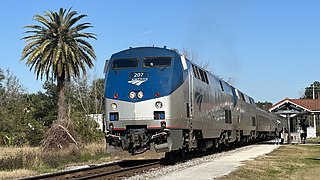
The Silver Meteor is a long-distance passenger train operated by Amtrak between New York City and Miami, Florida. Introduced in 1939 as the first diesel-powered streamliner between New York and Florida, it was the flagship train of the Seaboard Air Line Railroad (SAL) and one of the flagship trains of its successor, the Seaboard Coast Line Railroad (SCL). The train was transferred to Amtrak when it took over intercity passenger rail service in 1971.

The Silver Star is a temporarily discontinued long-distance passenger train operated by Amtrak on a 1,522-mile (2,449 km) route between New York City and Miami via Washington, D.C.; Richmond, Virginia; Raleigh, North Carolina; Columbia, South Carolina; Savannah, Georgia; Jacksonville, Florida; and Tampa, Florida.

The Palmetto is a passenger train operated by Amtrak on a 829-mile (1,334 km) route between New York City and Savannah, Georgia, via the Northeast Corridor, Washington, D.C., Richmond, Virginia, Fayetteville, North Carolina, and Charleston, South Carolina. The Palmetto is a shorter version of the Silver Meteor, which continues south to Miami, Florida. From 1996 to 2002 this service was called the Silver Palm. Although currently a day train, the Palmetto is considered a long-distance train by Amtrak and previously provided overnight sleeper service to Florida.
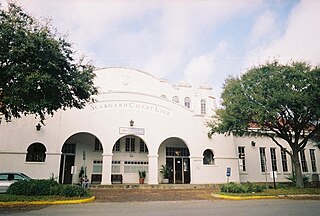
Orlando Health/Amtrak station, also known as Orlando station, is a train station in Orlando, Florida. It is served by Amtrak, the national railroad passenger system of the United States, and SunRail, the commuter rail service of Greater Orlando, as well as local and intercity buses. It serves Amtrak's Silver Meteor and Floridian lines. Built in 1926, the historic station is located in Downtown Orlando approximately one mile south of the central business district, near the campus of Orlando Health. Serving 160,442 passengers at last measure in 2013, The station is Amtrak's fifth busiest in the Southeastern United States; it is the second busiest Amtrak station in Florida, behind the Sanford station of the Auto Train.

The Ocala Union Station is a bus station and former train station in Ocala, Florida, United States. It is located at 531 Northeast First Avenue, and was built in 1917 by both the Atlantic Coast Line and Seaboard Air Line Railroad. Prior to this, ACL and SAL had separate depots in Ocala. The former ACL station was originally built by the Florida Southern Railroad, while the former SAL station was built by the Florida Transit and Peninsular Railroad. On December 22, 1997, it was added to the U.S. National Register of Historic Places.

Palatka station is an Amtrak train station in Palatka, Florida. It is served by the daily Floridian and Silver Meteor trains. The 1908-built station houses the Palatka Railroad Preservation Society and the David Browning Railroad Museum. It was added to the National Register of Historic Places in 1988 as Old A.C.L. Union Depot.
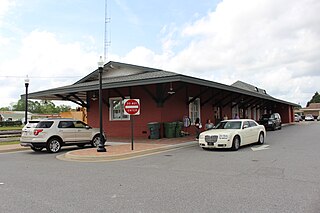
Jesup station is a railroad station in the city of Jesup, Wayne County, Georgia, United States. Located at 176 Northwest Broad Street, the station is currently in use for service on Amtrak's Silver Meteor and bypassed by their Auto Train and Floridian. Amtrak service began on October 1, 1979, when the Silver Meteor was realigned away from a station on State Route 32 at Thalmann, Georgia.
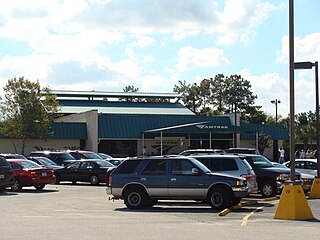
Jacksonville station is an Amtrak train station in the Northside neighborhood of Jacksonville, Florida, United States. It is served by the Floridian and Silver Meteor trains as well as Amtrak Thruway buses.

Sebring station is an Amtrak train station in Sebring, Florida, United States. It is served by the Floridian and Silver Meteor.

The Champion was a streamlined passenger train operated by the Atlantic Coast Line Railroad and Florida East Coast Railway between New York City and Miami or St. Petersburg, Florida. It operated from 1939 until 1979, continuing under the Seaboard Coast Line and Amtrak. It was a direct competitor to the Seaboard Air Line Railway's Silver Meteor, the first New York-Florida streamliner.

Wildwood station is a bus station, and former train station, in Wildwood, Florida. It serves Amtrak Thruway buses and formerly served trains for Amtrak and other rail companies. The station is located on 601 North Main Street in Wildwood, Florida. Along with the northern terminus of Florida's Turnpike, the station gave Wildwood a reason to refer to itself as "The Crossroads of Florida."

Waldo station is a former train station in Waldo, Florida along the CSX S-Line. It serves Amtrak Thruway buses and previously served trains for Amtrak and other rail operators. The station is located at the interchange of US 301 and State Road 24 in Waldo, Florida.
The Wildwood Subdivision is a railroad line owned by CSX Transportation in Florida. It runs along CSX's S Line from Baldwin south to Zephyrhills via Ocala and Wildwood for a total of 155.7 miles. The S Line is CSX's designation for the line that was the Seaboard Air Line Railroad main line from 1903 to 1967.

The Yeoman Subdivision is a railroad line owned by CSX Transportation in Florida. It runs along CSX’s S Line from Zephyrhills south to just east of Tampa via Plant City for a total of 31.2 miles.
The Tampa and Gulf Coast Railroad (T&G) was a railroad company in the Tampa Bay Area of Florida in the United States. It initially built and operated a line that ran from the Tampa Northern Railroad main line in Lutz west to Tarpon Springs and into Pasco County. Additional track starting from Sulphur Springs running west towards Clearwater and south to St. Petersburg was built shortly after. The railroad was informally known as the "Tug n' Grunt" and the "Pea Vine" due to its frequent twists and turns. While it was the second railroad to serve St. Petersburg and Clearwater after the Orange Belt Railway, it had the advantage of being the first to connect the area directly with Tampa.
The Tampa and Thonotosassa Railroad was a 13-mile railroad line running from Tampa, Florida northeast to Thonotosassa. The line began operation in 1893 and began at a junction with the South Florida Railroad in Tampa. The line had a station in Thonotosassa. The line was bought out by the Plant System in 1901 which was then sold to the Atlantic Coast Line Railroad in 1902.
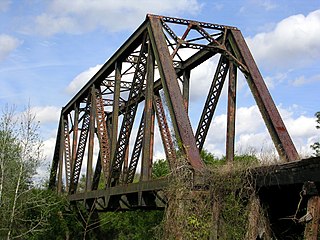
The Seaboard Air Line Railroad's Sarasota Subdivision was a rail line that ran from the company's main line at Turkey Creek south to Palmetto, Bradenton, Sarasota, and Venice. The line was built in phases from 1901 to 1911.
The Atlantic Coast Line Railroad's DuPont—Lakeland Line was a historic rail line in southern Georgia and the northern west coast of Florida. On employee timetables, the line was actually divided into the DuPont—High Springs Line and the High Springs—Lakeland Line. The line was primarily used for freight, though some passenger services ran on parts of it in Florida. While parts of the line were built as early as 1863, the full line was not complete until 1913. Parts of the line in Florida are still active today.
The Seaboard Air Line Railroad’s Main Line was the backbone of the Seaboard Air Line Railroad's network in the southeastern United States. The main line ran from Richmond, Virginia to Tampa, Florida, a distance of over 800 miles. Along its route it passed through Petersburg, Raleigh, Columbia, Savannah, Jacksonville, and Ocala, Florida. While some segments of the line have been abandoned as of 2023, most of the line is still in service and is owned by the Seaboard Air Line's successor, CSX Transportation as their S-Line.





















